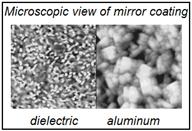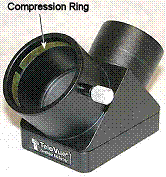Diagonally Speaking
Jack Kramer
Premium eyepieces can be a lifetime investment that will perform superbly in any telescope you'll ever own. For those of us with SCTs and refractors, I also place a good star diagonal in that same category.
So why make a fuss about a lowly star diagonal? Well, they're not all created equal. Basically, a star diagonal is designed to redirect the light at a 90o angle so it's easier for the observer to use the telescope, especially when it's aimed at an object higher in the sky. To do this, either a right-angle prism or a front surface mirror is used. Lesser quality star diagonals can have a number of problems, in-cluding light loss and scatter, misalignment, and flimsy con-struction that allows the diagonal to sag under the weight of heavy eyepieces or a camera.
I had often read that since light passes through a lot of glass in a prism, there is notable light loss. Thus, front-surface mirrors are the preferred means for redirecting the light. About a dozen years ago, this prompted me to buy a Vixen 11/4" mirror diagonal to replace the prism diagonal on my Celestron/Vixen refractor. However, I could not detect any improvement, and upon doing a comparison back-and-forth, I found that the original prism diagonal actually transmitted light a bit better. But recently there has been a greater emphasis on higher quality mirror diagonals, and as a result many people now find that upgrading the star di-agonal in their scopes is well worthwhile.
Standard aluminized mirror diagonals usually advertise a reflectivity around 88% to 90% and enhanced aluminum may up that to around 96%. Within the last decade the quality of mirror diagonals has improved further with the introduction of dielectric mirrors. The better dielectrics feature reflectivity approaching 99%, plus most boast of a 1/10 wave accuracy of the glass surface (the "substrate"). An additional advantage is less light being scattered. Ac-cording to Roland Christen of Astro-Physics, examination with a laser shows approximately a fivefold improvement in surface scatter. This is because an aluminum layer con-sists of droplets each being on the order of one wavelength of light in size. On the contrary, dielectric coatings are mul-tiple layers of very thin film oxides (often over forty layers) made of much smaller particles deposited by an ion beam evaporator at high temperature. Finally, dielectric coatings are much more durable, being able to stand up to repeated cleanings with virtually no degradation of the coating. By contrast, at least one analysis showed that after ten years the reflectivity of a typical aluminum coated star diagonal declines to the range of 83% to 85%.
 Another thing worth having is a compression ring fitting to hold the eyepiece more securely without marring the finish on the barrel. Virtually all the better quality star diagonals now include compression rings. And if your focuser can take 2" format accessories, then it's wise to get a 2" star diagonal. They usually come with 11/4" adapters so you can use both eyepiece sizes. There also are types of star diagonals with attachment rings that will thread onto the rear cell of an SCT and others are threaded so filters can be installed in the barrel of the star diagonal.
Another thing worth having is a compression ring fitting to hold the eyepiece more securely without marring the finish on the barrel. Virtually all the better quality star diagonals now include compression rings. And if your focuser can take 2" format accessories, then it's wise to get a 2" star diagonal. They usually come with 11/4" adapters so you can use both eyepiece sizes. There also are types of star diagonals with attachment rings that will thread onto the rear cell of an SCT and others are threaded so filters can be installed in the barrel of the star diagonal.
 You've probably also seen diagonals that redirect the im-age at an angle of 45o instead of 90o. These are intended for use in terrestrial viewing and can be rather awkward for astronomical purposes. Moreover, they usually employ special prisms to provide an erect image, and in so doing, there is a loss of light throughput.
You've probably also seen diagonals that redirect the im-age at an angle of 45o instead of 90o. These are intended for use in terrestrial viewing and can be rather awkward for astronomical purposes. Moreover, they usually employ special prisms to provide an erect image, and in so doing, there is a loss of light throughput.
While dielectric diagonals are more durable than those with aluminum-coated mirrors, the down side is that for all prac-tical purposes they cannot be re-coated if they sustain some damage or eventually deteriorate. The original di-electric coating would have to be ground off the mirror and the substrate would then have to be re-figured, making it cost prohibitive.
I use the same 2" Tele Vue Everbrite star diagonal on my 6-inch and 4-inch apochromats, despite the fact that a di-agonal came with the 4-inch. The difference between the premium diagonal and the standard issue one is noticeable. Expect to pay quite a bit more for a dielectric star diagonal, but I feel it's money well spent.
As a side note, dielectric secondary mirrors are also sold for use in Newtonian telescopes. According to the literature, they provide the same advantages as when used in star diagonals for refractors and SCTs.
Published in the June 2009 issue of the NightTimes




